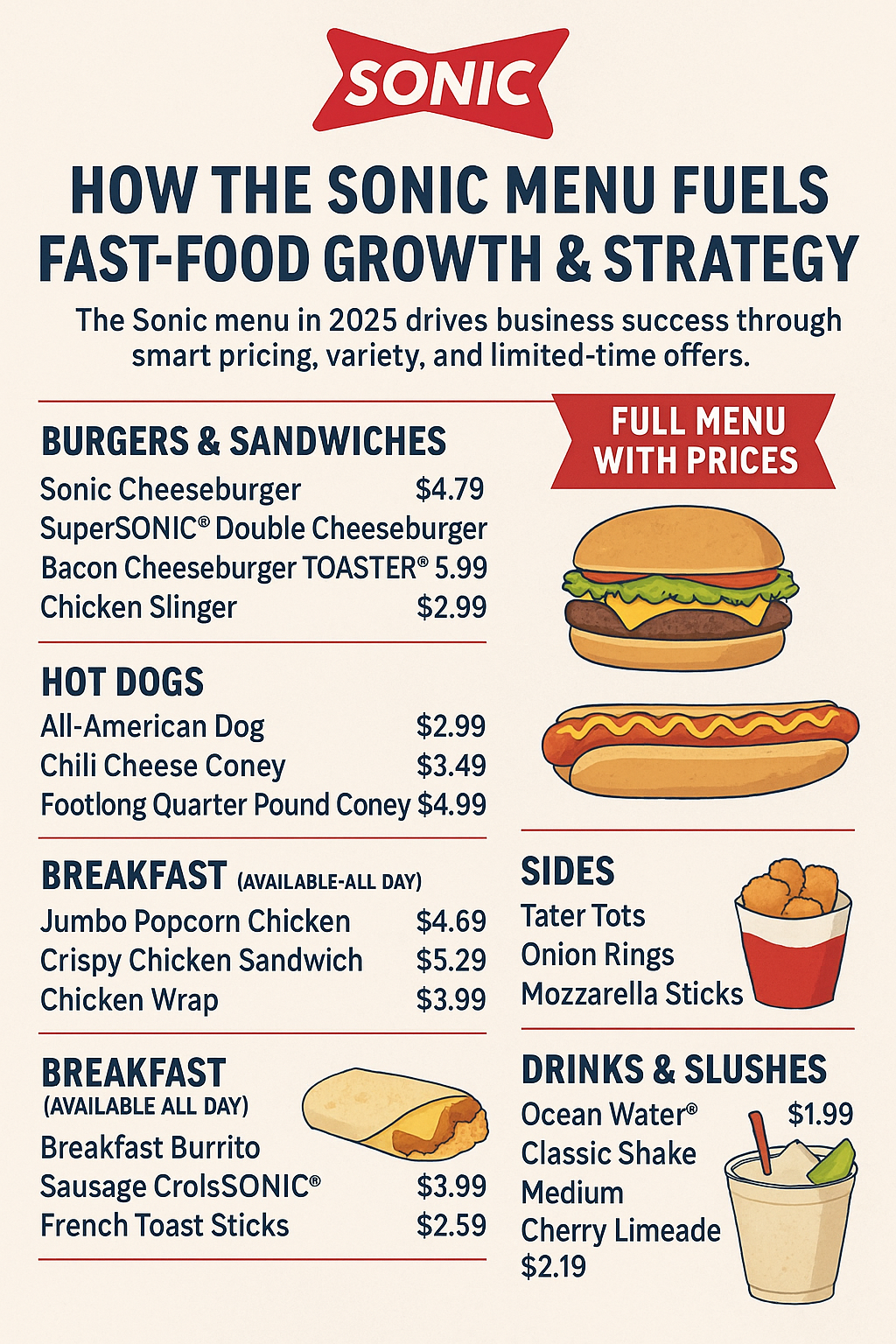The fast-food landscape is evolving. With rising costs, changing consumer expectations, and fierce competition, brands like Sonic Drive-In are under pressure to deliver both value and quality. The Sonic menu has become a prime example of how a well-structured offering can meet customer needs while supporting business growth.
Balancing price and quality isn’t about being the cheapest or the most premium—it’s about finding the right mix. Sonic achieves this balance through smart product placement, consistent pricing strategies, and a deep understanding of what its customers actually want.
How Sonic’s Menu Strategy Works Behind the Scenes
Sonic’s approach starts with a deep knowledge of its target market. Its customers want flexibility, crave familiar flavors, and often prioritize convenience. That’s why the Sonic menu offers both affordable classics and premium upgrades.
Items like the Sonic Cheeseburger or the All-American Dog offer satisfying portions at accessible price points. At the same time, limited-time offers like the Steak Butter Bacon Cheeseburger appeal to those willing to spend more for unique flavors.
Sonic also bundles meals with sides and drinks—making the higher price point feel justified while subtly encouraging customers to increase their order value.
Sonic Menu With Prices – 2025 Snapshot
To understand how Sonic finds its pricing balance, it helps to look at the Sonic menu with prices:
Burgers & Sandwiches
- Sonic Cheeseburger – $4.79
- SuperSONIC® Double Cheeseburger – $6.29
- Chicken Slinger – $2.99
- Bacon Cheeseburger TOASTER® – $5.99
Hot Dogs
- All-American Dog – $2.99
- Chili Cheese Coney – $3.49
- Footlong Quarter Pound Coney – $4.99
Chicken
- Jumbo Popcorn Chicken – $4.69
- Crispy Chicken Sandwich – $5.29
Breakfast (All Day)
- Breakfast Burrito – $3.29
- Sausage CroisSONIC® – $3.99
Sides & Snacks
- Mozzarella Sticks (5 pc) – $3.79
- Tater Tots (Medium) – $2.29
- Onion Rings – $2.99
Drinks & Slushes
- Classic Shake (Medium) – $3.29
- Cherry Limeade – $2.19
- Ocean Water® – $1.99
These prices create clear entry points for both budget-conscious and value-seeking customers.
How Sonic Preserves Quality Across Price Points
Maintaining consistent quality across varying prices is a challenge for any restaurant, especially in quick service. Sonic addresses this by:
- Using common ingredients across different menu items to ensure freshness and reduce waste
- Training staff to follow strict preparation standards
- Streamlining kitchen operations for better consistency
- Limiting customizations where necessary to speed up prep and control portion sizes
Sonic also prioritizes taste and visual appeal, especially in popular categories like burgers and slushes. Even low-cost items are designed to feel indulgent.
Why Pricing Matters in Fast-Food Business Models
Pricing is more than just numbers. It influences how people perceive your brand. Sonic positions itself between value chains like McDonald’s and higher-end players like Shake Shack.
This mid-tier pricing lets Sonic:
- Reach wider audiences without sacrificing brand identity
- Maintain profit margins even on promotional deals
- Use higher-quality ingredients where it counts
- Experiment with limited-time items that test new flavors without major cost risks
For franchisees, this balance supports sustainable operations and revenue growth. For customers, it signals trust and reliability.
How Sonic Menu Variety Adds Business Value
Another strength of the Sonic menu is its extensive variety—without being overwhelming. It includes:
- Classic burgers and chicken sandwiches
- All-day breakfast options
- Hot dogs with customizable toppings
- Frozen drinks and slushes with flavor mix-ins
- Sides that cater to both adults and kids
This broad offering serves multiple meal occasions—breakfast, lunch, snacks, dinner—and appeals to all age groups. For business, that means more sales opportunities throughout the day.
How Sonic Leverages Seasonal and Digital Pricing
Sonic uses seasonal promotions to create urgency and attract new traffic. Items like the Pickle Juice Slush or Brownie Batter Shake generate buzz and media coverage. These LTOs (limited-time offers) also allow price flexibility without affecting the main menu structure.
The Sonic app adds another layer of value. Mobile-exclusive deals, rewards points, and combo upgrades give customers perceived savings while increasing order frequency. From a business standpoint, digital channels also collect valuable data to optimize pricing and promotions further.
Conclusion: A Balanced Menu Built on Smart Strategy
The Sonic menu isn’t just built for taste—it’s designed for performance. By carefully managing prices, quality, and customer expectations, Sonic has created a model that balances business goals with customer satisfaction. Whether you’re grabbing a $2 snack or a $10 meal combo, you feel like you’re getting a fair deal.
This balance is what allows Sonic to thrive in a competitive space—and it’s a model that food businesses everywhere can learn from.
Visit here for more Informational Blogs.







